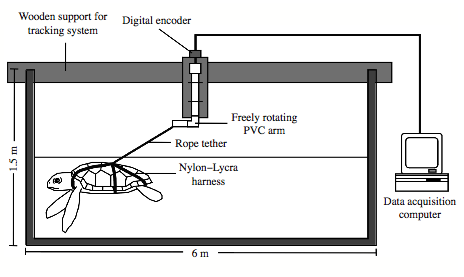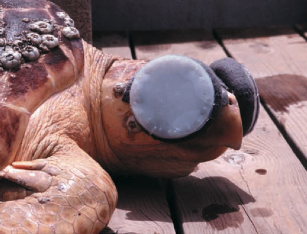Turtle Migration
Biology 342 Fall 2011
Hannah Schaupp, Shelly Skolfield, and Michaela Voorhees
Mechanism
Proposed Navigation Methods (Oceanic and Offshore)
- Magnetic Field
- Celestial
- Chemical Gradients
- Landmarks
- Wave Direction
Magnetic Field
Hatchlings of Loggerhead turtles take the North Atlantic Gyre, a current in the Atlantic. They are more likely to survive if stay in this current [7]. It is known that Loggerhead sea turtle hatchlings are able to detect magnetic field intensity and the inclination angle of field lines leading to the possiblility that hatchlings have a map sense (find specific places in the sea) [7]. The Lohmann laboratory placed Loggerhead hatchlings in a pool that allowed them to track the turtle’s movement and change the magnetic field the turtle would experience. The researchers changed the magnetic field in the pool to resemble a location far from the loggerhead sea turtles normal migratory route. There was not a significant difference between the test subjects orientation and random orientation. However, when turtles experienced fields they would encounter along the migratory route the turtles oriented to stay in the gyre and continue on their path [7].

Figure 1.Experimental set-up for Lohmann experiments with hatchling loggerhead turtles to determine effect of changes in magnetic field on navigation.[7]
In 2007, an experiment by P. Luschi, et. Al. showed that sea turtle adults use magnetic fields to navigate. Female Green Sea Turtles were taken 100-200 km from their egg laying beaches and tracked by satellite on their return. Three experimental groups were formed: the control, turtles with magnets on their head while navigating, and turtles with magnet on head while transporting from the beach. After the routes of the turtles had been corrected for sea current, both groups with magnets took significantly more circuitous routes back to the beach than the control indicating that magnetoreception is used in navigation but is not necessary[12].
How the turtles actually sense the magnetic fields is unknown. A few hypothesis have been suggested, either magnetite or magnetoreception in photoreceptors. Magnetite has been found in the brains of sea turtles, but no specific evidence of a link between the magnetite and magnetoreception has been found. The second hypothesis is weakened by an experiment done by the Lohmann laboratory, which suggested that sea turtle’s compass is independent of light [12].
Figure 2. Frosted Goggles used in experiment by Lohmann laboratory to block visual cues.[2]
Visual and Magnetic
An experiment by the Lohmann laboratory showed that Juvenile Loggerhead turtles could orient themselves with only visual or magnetic cues but their navigation was altered with out both cues (Figure 1)[2].
Wave Direction, Landmarks, and Chemical Cues
Hatchling Loggerhead turtles use wave direction to travel out to sea while they are close to shore [8]. Juvenile Loggerhead turtles in one experiment were able to orient with out landmarks, wave cues, or chemical cues although these still might be possibilities [2].
